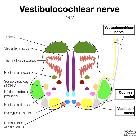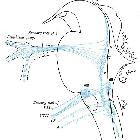Vestibular nuclei




The vestibular nuclei are a group of four small special sensory nuclei in the lower pons and upper medulla for the vestibular nerve component of the vestibulocochlear nerve. They are part of the extensive cranial nerve nuclei within the brainstem.
Gross Anatomy
There four nuclei are located adjacent to each other in the lower dorsal pons extending into the upper dorsal medulla, located under the lateral corner (vestibular area) of the fourth ventricle. The four nuclei are:
- largest of the vestibular nuclei
- lateral and superior to the nucleus ambiguus and dorsal vagal nucleus
- extends from the level of the upper olive to the lower pons
- located cranial to the inferior nucleus and ventral and lateral to the medial nucleus
- extends from the abducens nucleus to the superior nucleus
- major contributor of fibers to the lateral vestibulospinal tract
- located cranial to the medial and lateral nuclei
- extends the highest into the pons than the other vestibular nuclei
- smallest of the vestibular nuclei
- located between the medial nucleus and the restiform body
- extends from the upper limit of the nucleus gracilis to the pontomedullary junction
From all the nuclei, second-order sensory neurons project extensively into the brainstem, thalami and cerebellum including important connections with the medial longitudinal fasciculus.
Vestibular afferent fibers enter the brainstem at the pontomedullary junction lateral to the facial nerve as part of the vestibulocochlear nerve and pass medial to the inferior cerebellar peduncle before synapsing in the nuclei.
Innervation
The nucleus houses the sensory cell bodies of the vestibular nerve which relay vestibular, posture and equilibrium information to various components of the brainstem and cerebellum.
Siehe auch:

 Assoziationen und Differentialdiagnosen zu Nuclei vestibulares:
Assoziationen und Differentialdiagnosen zu Nuclei vestibulares:
